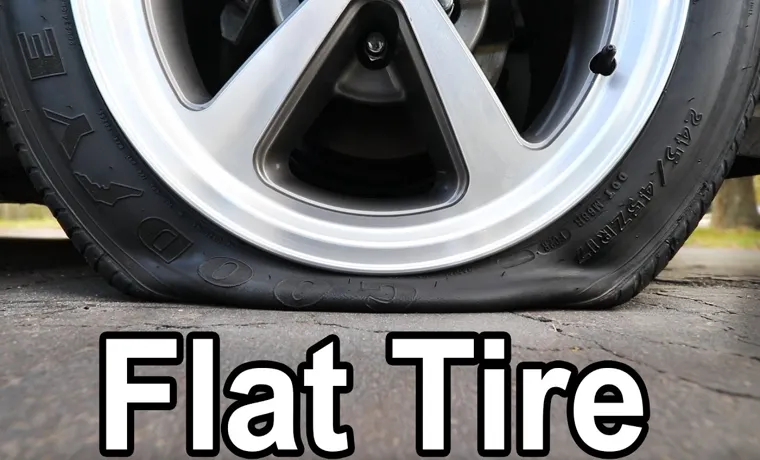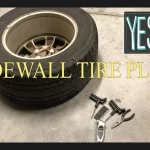Picture this: you’re driving down the road, enjoying your day when suddenly you hear a loud pop and feel your car start to wobble. You pull over to the side of the road and realize that your tire has gone flat. It’s a stressful situation, and not everyone knows what to do.
If you’ve ever found yourself in this predicament, don’t panic! In this blog post, we’ll go over some tips for dealing with a flat tire and getting back on the road as quickly and safely as possible. Whether you’re a seasoned driver or a new one, this information will be valuable to you. So, buckle up and get ready to learn!
Table of Contents
Assess the Situation
Having a flat tire can be quite a frustrating experience, especially if you’re in a hurry or far from home. Before you panic, it’s important to assess the situation. If you notice the tire has completely lost air, turn on your hazard lights and pull over to a safe spot on the side of the road.
Make sure your car is safely away from traffic, and engage the emergency brake. If you have a spare tire, check if it’s in good condition and ready to use. If not, don’t attempt to drive your car without a good tire.
Instead, call a roadside assistance service or a trusted mechanic who can come and fix your flat tire on the spot. Remember, it’s always better to be safe than sorry when it comes to flat tires.
Safety First
When it comes to maximizing safety in any given situation, the first step is to assess the situation itself. Take a moment to evaluate the immediate environment and identify any potential hazards or dangers that could potentially crop up. This could be anything from loose floorboards to uneven terrain to dangerous animals or hidden obstacles.
Once you’ve identified these potential hazards, you can take steps to mitigate the risks and ensure that you’re able to move forward safely. By taking the time to assess the situation and prioritize safety, you’ll be better equipped to handle whatever curveballs life throws at you. Remember, safety should always come first, no matter what the situation may be.

Check the Tire
When you notice that your car is pulling to one side, or you hear a thumping sound coming from one of your wheels, it’s important to assess the situation right away. Checking the tire may help you figure out what’s causing the problem. You should first visually inspect the tire for any visible cuts, bulges, or nails that may be causing a damage.
A tire with low air pressure can also cause uneven wear and tear, so it’s important to check the pressure of all four tires regularly. If you notice that the tire tread is worn down to the wear bars, it’s time to replace the tire to prevent any accidents. By taking these steps, you’ll be able to maintain a safe, smooth ride and avoid any expensive repairs down the road.
Remove the Flat Tire
Removing a flat tire can be a daunting experience, but the first step is to assess the situation and determine the best course of action. Begin by finding a safe location away from traffic to change the tire. Make sure your vehicle is turned off and the emergency brake is engaged.
Next, examine the tire to determine the cause of the flat. If there is a nail or other puncture in the tire, it may be repairable. However, if the tire is severely damaged or completely blown out, it will need to be replaced.
Once the situation has been evaluated, carefully remove the flat tire by loosening the lug nuts with a lug wrench and lifting the vehicle with a jack. With some patience and careful attention, you will be back on the road in no time.
Install the Spare Tire
If you find yourself with a flat tire, the first thing to do is to safely find a place to pull over. Once you’ve done that, it’s time to install the spare tire. The spare tire is an essential item that every vehicle should have.
To install it, first, locate it in the trunk or underneath the car. Remove any materials that may be covering it. Next, use a lug wrench to loosen the lug nuts on the flat tire.
Then, jack up the car using the recommended jacking points and remove the flat tire. Finally, place the spare tire in the same location and tighten the lug nuts by hand as much as you can. Once the car is back on the ground, securely tighten the lug nuts in a star pattern until they are snug, being careful not to over-tighten them.
Always make sure to check the tire pressure of the spare tire as soon as possible and never drive on it for an extended period of time.
Find the Spare Tire and Jack
When you find yourself with a flat tire, it’s essential to know how to install a spare tire correctly. The first step is to locate the spare tire and jack in the trunk of your car. Most cars have these stored somewhere in the trunk, usually underneath the floor mat or in a dedicated compartment.
Once you’ve found them, it’s essential to position your car safely on a flat surface away from traffic before lifting the car with the jack. Make sure to refer to your car’s owner’s manual for the correct jack placement and lifting points. Once the car is lifted, remove the flat tire and replace it with the spare.
Then, slowly lower the car, tighten the lug nuts, and check the tire’s pressure. Remember, it’s crucial to get the flat tire repaired or replaced as soon as possible, so don’t delay getting it fixed. With these steps, installing a spare tire can be done quickly and safely, keeping you on the road and on your way.
Place the Jack Under the Car
When it comes to changing a tire, one of the most important steps is placing the jack under the car. The jack is what will lift the car off the ground so that you can remove the flat tire and replace it with a spare. But before you start, it’s important to make sure that you have parked on a flat, level surface and set your parking brake.
You’ll also want to place wheel chocks around the other tires to prevent the car from rolling. Once you’ve done all of that, you can position the jack under the designated jacking point for your vehicle. This can typically be found in your car’s owner’s manual or on a sticker located near the jack.
Once the jack is in place, use the handle to pump it up and lift the car off the ground. Remember to always double-check the jack’s stability before getting underneath the car to remove the tire. By following these steps, you’ll be able to easily install the spare tire and get back on the road in no time.
Install the Spare
When it comes to changing a flat tire, installing the spare tire is the next step. Firstly, make sure that the spare is in good condition and suitable for the vehicle. Begin by aligning the holes on the rim with the wheel studs, then carefully lift the spare onto the wheel studs.
Hand tighten the lug nuts to hold the tire in place. Secondly, use a wrench to tighten the lug nuts but do not overtighten them. Once the tire is securely in place, take the flat tire and the necessary equipment and stow them safely back into the vehicle’s trunk.
It’s important not to drive on the spare tire for long distances or at high speeds as it’s not designed for regular use. Remember, if you don’t feel comfortable changing a tire, always contact a professional for assistance.
Get the Tire Fixed or Replaced
What to do with a flat tire? It can be a frustrating and unexpected situation, but there are a few things you can do to get back on the road. First, pull over to a safe spot on the side of the road and turn on your hazard lights. Then, assess the damage to the tire.
If it’s a minor puncture or leak, you may be able to fill it with a tire repair kit, which can be found at most auto shops. If the damage is more severe, such as a large puncture or sidewall damage, the tire will need to be replaced. In this case, call for roadside assistance or use your spare tire if you have one.
It’s important to get the tire either fixed or replaced as soon as possible, as driving on a flat tire can cause damage to your wheel and suspension. So, don’t hesitate to take action when faced with a flat tire — a quick fix can save you a lot of time and money in the long run.
Repair the Flat Tire
Getting a flat tire is never fun, but it’s a problem that every car owner will eventually face. Whether you accidentally drove over a sharp object or your tire simply wore out over time, it’s important to get the issue fixed as soon as possible. In some cases, a simple repair will do the trick, but if the damage is too severe, you may need to replace the entire tire.
When deciding what to do, consider factors such as the age of your tires, the severity of the damage, and your budget. If you’re not sure what to do, don’t hesitate to consult a professional. A trained mechanic can give you an expert opinion and help you make an informed decision.
Remember, neglecting a flat tire can be dangerous and lead to further damage to your car or even cause an accident. So, if you find yourself with a flat, don’t delay—get it fixed or replaced today.
Replace the Flat Tire
Getting a flat tire is never a fun experience, but it doesn’t have to be a total nightmare. If you find yourself with a flat tire, the first thing you should do is pull over to a safe location, like a parking lot or a side street. Once you’re safely out of traffic, you should assess the damage to the tire.
If the tire can be repaired, you may be able to have it patched or plugged by a trained professional. However, if the damage is too severe, you’ll need to have the tire replaced entirely. It’s important to remember that driving on a flat tire can cause serious damage to your vehicle’s rims and suspension.
If you don’t feel comfortable changing the tire yourself, don’t hesitate to call for professional help. Safety should always be your top priority.
Conclusion
When life hands you a flat tire, don’t let it deflate your spirit! First, safely pull over to the side of the road. Then, take a deep breath and assess your options. You can call a friend or family member for assistance, use a spare tire or tire repair kit, or even call a tow truck.
Whatever you do, don’t let a flat tire get you down. Remember, every bump in the road is just an opportunity to learn and grow. So slap on that spare and get back on the road to adventure!”
FAQs
What should I do if I get a flat tire while driving?
The first step is to safely pull over to the side of the road. Then, locate your spare tire and tools necessary to change the tire. If you are unfamiliar with changing a tire, consult your car manual or call a roadside assistance service.
How can I prevent a flat tire?
Regularly checking your tire pressure and visually inspecting your tires for signs of wear and tear can help prevent a flat tire. Avoiding driving over sharp objects and rough terrain can also reduce your risk of getting a flat tire.
Can I drive on a flat tire?
It is not recommended to drive on a flat tire as it can cause damage to your wheel rim and suspension system. It can also cause loss of control and increase the risk of an accident.
What tire repair options are available for a flat tire?
If the tire has a small puncture, it may be possible to repair it with a patch or plug. However, if the damage is too severe, the tire may need to be replaced.
Should I replace all four tires if I get a flat tire?
It is not necessary to replace all four tires if only one tire has a flat. However, it is important to make sure that the new tire matches the same specifications as the other tires on your car.
How long can I drive on a spare tire?
Spare tires are designed to be temporary solutions and are not meant for prolonged use. It is recommended to only drive on a spare tire for a maximum of 50-70 miles and at a maximum speed of 50 mph.
What should I do with a flat tire?
Properly disposing of a flat tire is important for the environment. Local recycling centers or tire retailers may offer tire disposal services for a fee. In some cases, the retailer you purchased your new tire from may be able to dispose of the flat tire for you.


